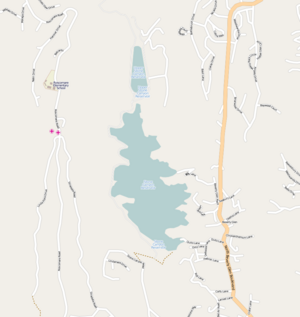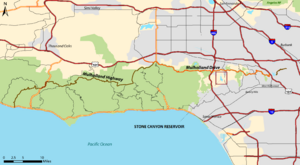Stone Canyon Reservoir facts for kids
Quick facts for kids Stone Canyon Reservoir |
|
|---|---|
| Coordinates | 34°6′40″N 118°27′16″W / 34.11111°N 118.45444°W |
| Built | 1952 |
| Surface elevation | 843 feet (257 m) |
| Settlements | Bel Air, Los Angeles, California, USA |
The Stone Canyon Reservoir and Upper Stone Canyon Reservoir are two connected reservoirs in the Westside area of Los Angeles, California. They are located in the Santa Monica Mountains in the Bel Air neighborhood. The reservoirs are about 847 feet (258 m) above sea level.
The main reservoir is called Stone Canyon Reservoir. The smaller, cone-shaped Upper Stone Canyon Reservoir is just north of it. Together, these reservoirs provide water to about 400,000 people. This includes residents in Pacific Palisades, parts of the Santa Monica Mountains, and West Los Angeles.
Contents
History of the Reservoirs
The Los Angeles Department of Water and Power (LADWP) owns these reservoirs. The larger, lower reservoir was built in 1924. It was designed by the Bureau of Water Works and Supply (BWWS), which is what the LADWP was called back then.
This reservoir was built using a method called hydraulic sluicing. This technique uses water to move earth and was made better by William Mulholland. When it was first built, the main reservoir could hold about 8,000 acre⋅ft (9,900,000 m3) of water.
Upgrades and Safety Checks
In the mid-1950s, part of the dam was rebuilt to make it stronger. This work finished in 1956. The dam is 160 feet (49 m) high. Engineers checked its safety to make sure it could handle earthquakes. Studies in 2002 showed that the Lower Stone Canyon Dam was safe. It could hold water up to its planned level of 865 feet (264 m).
How the Reservoirs Work
Stone Canyon Reservoir is actually two reservoirs: the larger Lower Reservoir and the Upper Reservoir. The Lower Reservoir is at 34°6′24″N 118°27′09″W / 34.10667°N 118.45250°W and the Upper is at 34°07′06″N 118°27′21″W / 34.11833°N 118.45583°W.
When they were first built, both reservoirs stored treated drinking water. However, rain and surface water could flow into them. This sometimes caused the water to become dirty.
Lower Reservoir Details
The Lower Reservoir has an uneven shape. Its shoreline is about 5,500 feet (1,700 m) long, and its surface area is 117 acres (47 ha). A water treatment plant was built downstream in January 1952. It cost around $9 million to build the plant and other parts of the system.
The plant was designed to use the natural shape of the land. This helped save money and made the structure strong. In 1984, there was an unusual change in radon levels in the canyon. This might have been because the reservoir's water level changed.
Some parts of the lower reservoir were lined with asphalt to help prevent leaks. To clear brush and reduce fire risks, heavy drums filled with water were rolled up and down the slopes.
Water Quality Concerns
Because the reservoirs were open to the air, their water quality sometimes did not meet new standards for drinking water. Government rules said that smaller reservoirs needed to be covered. Also, large ones needed filtration plants. So, the LADWP was told to build a new filtration plant below the dam. This plant would be on a 13 acres (5.3 ha) area.
Studies in 1991 showed that the water in both reservoirs had high turbidity. Turbidity means the water was cloudy. It was cloudier than the allowed limit. The studies also found higher levels of bacteria in the Lower Reservoir. During summer, there was a lot of algae. These issues meant a new water treatment plant was needed.
To fix these problems, a new membrane filtration and pumping facility was built. It cost about $65 to $70 million. This plant can supply 6.5 million US gallons (25,000 m3) of water per day to 400,000 customers. A security fence was also put up around the new facility.
Changes to the Lower Stone Canyon Reservoir
In 2004, plans were made to improve the water treatment even more. The goal was to remove any possible contaminants from the Lower Stone Canyon Reservoir water. A new microfiltration plant was built to treat the surface water. It uses special membranes and chemicals to clean the water before it goes to homes.
This new plant can also be controlled remotely and automatically. It was built in a valley near the dam. The design made sure it blended in with the natural area. It also kept noise levels very low. This project, called "The Stone Canyon Water Quality Improvement Project," cost $75 million. Construction started in 2004 and finished by the end of 2007.
At the same time, the LADWP also spent $132 million over five years to improve the security of the city's water system. This was done after the events of 9/11.
Current Use of the Lower Reservoir
After these upgrades, the Lower Stone Reservoir is not used for everyday water supply. It is now kept for emergencies only. A special bypass pipeline, 63 inches (1,600 mm) wide and 8,000 feet (2,400 m) long, was built. Half of this pipe runs under the lower reservoir. It carries treated water directly from the Los Angeles Aqueduct Filtration Plant in Sylmar to customers.
The lower reservoir can hold 3.38 billion US gallons (12,800,000 m3) of water. The upper reservoir can store 138 million US gallons (520,000 m3). The upper reservoir has special channels to protect it from surface runoff, but the lower one does not. Also, the lower reservoir no longer directly supplies water to people.
If there are heavy rains and floods, the reservoirs might be taken out of service. If there's a very big storm, the Upper Stone Canyon Reservoir can spill water into the lower reservoir. This water then goes through the filtration plant before being sent to customers.
Future of the Upper Stone Canyon Reservoir
There is a plan to replace the Upper Stone Canyon Reservoir. The idea is to build three underground reservoirs beneath it. These would store 81 million US gallons (310,000 m3) of water. The underground structures would be covered with soil and local plants. Hiking trails might also be built over the area for people to enjoy.
The main reason for this project is to follow federal rules for uncovered reservoirs. The lower reservoir is already mostly out of use, except for emergencies. It has a small water treatment plant for those times. If there's a fire, the lower reservoir can provide water for firefighting. This project also helps improve water security. In 2009, studies were still being done to see how this project would affect the environment.
Stone Canyon in Movies and Books
The reservoir has appeared in movies and novels.
- In 1974, the movie Chinatown used the reservoir as a filming location.
- The beginning of Irving Wallace's 1974 novel The Fan Club is set overlooking Stone Canyon Reservoir.
- Page two of Sunset Express, a 1996 detective novel by Robert Crais, also takes place by the reservoir.
Stone Canyon Overlook
The Mulholland Scenic Parkway and Corridor is a famous road in the US. It includes 24 miles (39 km) of Mulholland Drive, which passes through Los Angeles. This road was built in 1924 to offer amazing views of the mountains, beaches, and reservoirs.
In 1994, the Stone Canyon Reservoir Overlook was created on the south side of Mulholland Drive. This spot gives visitors a great view of the reservoir.
Fishing at Stone Canyon
If you want to fish in Stone Canyon Reservoir, you should check with local guides and resources. They can tell you about the rules and best places to fish.





